 | –≠–ª–µ–∫—Ç—Ä–æ–Ω–Ω—ã–π –∫–æ–º–ø–æ–Ω–µ–Ω—Ç: LM5104SD | –°–∫–∞—á–∞—Ç—å:  PDF PDF  ZIP ZIP |

LM5104
High Voltage Half-Bridge Gate Driver with Adaptive
Delay
General Description
The LM5104 High Voltage Gate Driver is designed to drive
both the high side and the low side N-Channel MOSFETs in
a synchronous buck configuration. The floating high-side
driver is capable of working with supply voltages up to 100V.
The high side and low side gate drivers are controlled from a
single input. Each change in state is controlled in an adap-
tive manner to prevent shoot-through issues. In addition to
the adaptive transition timing, an additional delay time can
be added, proportional to an external setting resistor. An
integrated high voltage diode is provided to charge high side
gate drive bootstrap capacitor. A robust level shifter operates
at high speed while consuming low power and providing
clean level transitions from the control logic to the high side
gate driver. Under-voltage lockout is provided on both the
low side and the high side power rails. This device is avail-
able in the standard SOIC-8 pin and the LLP-10 pin pack-
ages.
Features
n
Drives both a high side and low side N-channel
MOSFET
n
Adaptive rising and falling edges with programmable
additional delay
n
Single input control
n
Bootstrap supply voltage range up to 118V DC
n
Fast turn-off propagation delay (25 ns typical)
n
Drives 1000 pF loads with 15 ns rise and fall times
n
Supply rail under-voltage lockout
Typical Applications
n
Current Fed Push-Pull Power Converters
n
High Voltage Buck Regulators
n
Active Clamp Forward Power Converters
n
Half and Full Bridge Converters
Package
n
SOIC-8
n
LLP-10 (4 mm x 4 mm)
Simplified Block Diagram
20089003
FIGURE 1.
January 2004
LM5104
High
V
oltage
Half-Bridge
Gate
Driver
with
Adaptive
Delay
© 2004 National Semiconductor Corporation
DS200890
www.national.com
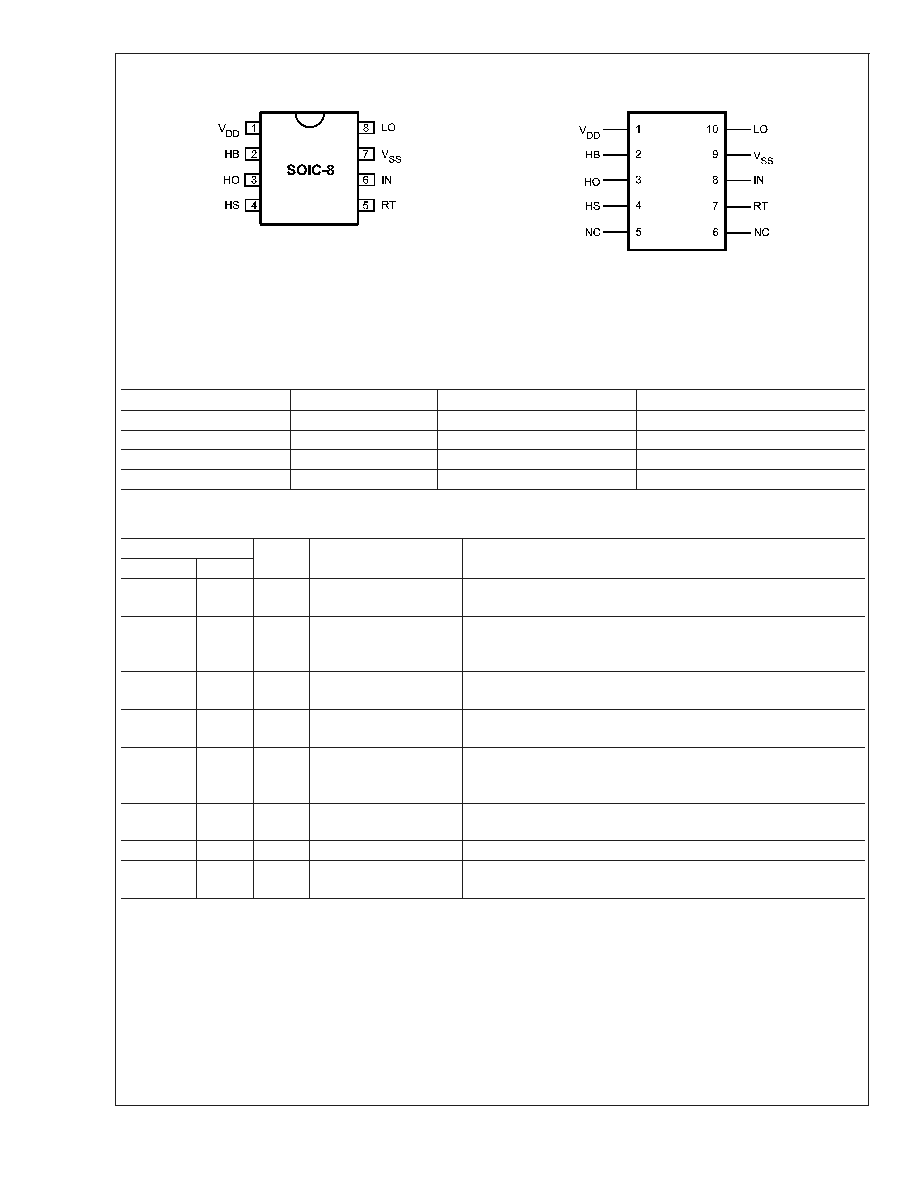
Connection Diagram
Ordering Information
Ordering Number
Package Type
NSC Package Drawing
Supplied As
LM5104M
SOIC-8
M08A
Shipped with Anti-Static Rails
LM5104MX
SOIC-8
M08A
2500 shipped as Tape & Reel
LM5104SD
LLP-10
SDC10A
1000 shipped as Tape & Reel
LM5104SDX
LLP-10
SDC10A
4500 shipped as Tape & Reel
Pin Descriptions
Pin
Name
Description
Application Information
SOIC-8
LLP-10
1
1
V
DD
Positive gate drive supply Locally decouple to V
SS
using low ESR/ESL capacitor, located as
close to IC as possible.
2
2
HB
High side gate driver
bootstrap rail
Connect the positive terminal of bootstrap capacitor to the HB pin
and connect negative terminal to HS. The Bootstrap capacitor should
be placed as close to IC as possible.
3
3
HO
High side gate driver
output
Connect to gate of high side MOSFET with short low inductance
path.
4
4
HS
High side MOSFET
source connection
Connect to bootstrap capacitor negative terminal and source of high
side MOSFET.
5
7
RT
Deadtime programming
pin
Resistor from RT to ground programs the deadtime between high
and low side transitions.The resistor should be located close to the
IC to minimize noise coupling from adjacent traces.
6
8
IN
Control input
Logic 1 equals High Side ON and Low Side OFF. Logic 0 equals
High Side OFF and Low Side ON.
7
9
V
SS
Ground return
All signals are referenced to this ground.
8
10
LO
Low side gate driver
output
Connect to the gate of the low side MOSFET with a short low
inductance path.
Note: For LLP-10 package, it is recommended that the exposed pad on the bottom of the LM5100 / LM5101 be soldered to ground plane on the PC board,
and the ground plane should extend out from beneath the IC to help dissipate the heat. Pins 5 and 6 have no connection.
20089001
8-Lead SOIC
See NS Package Number M08A
20089002
10-Lead LLP
See NS Package Number SDC10A
FIGURE 2.
LM5104
www.national.com
2
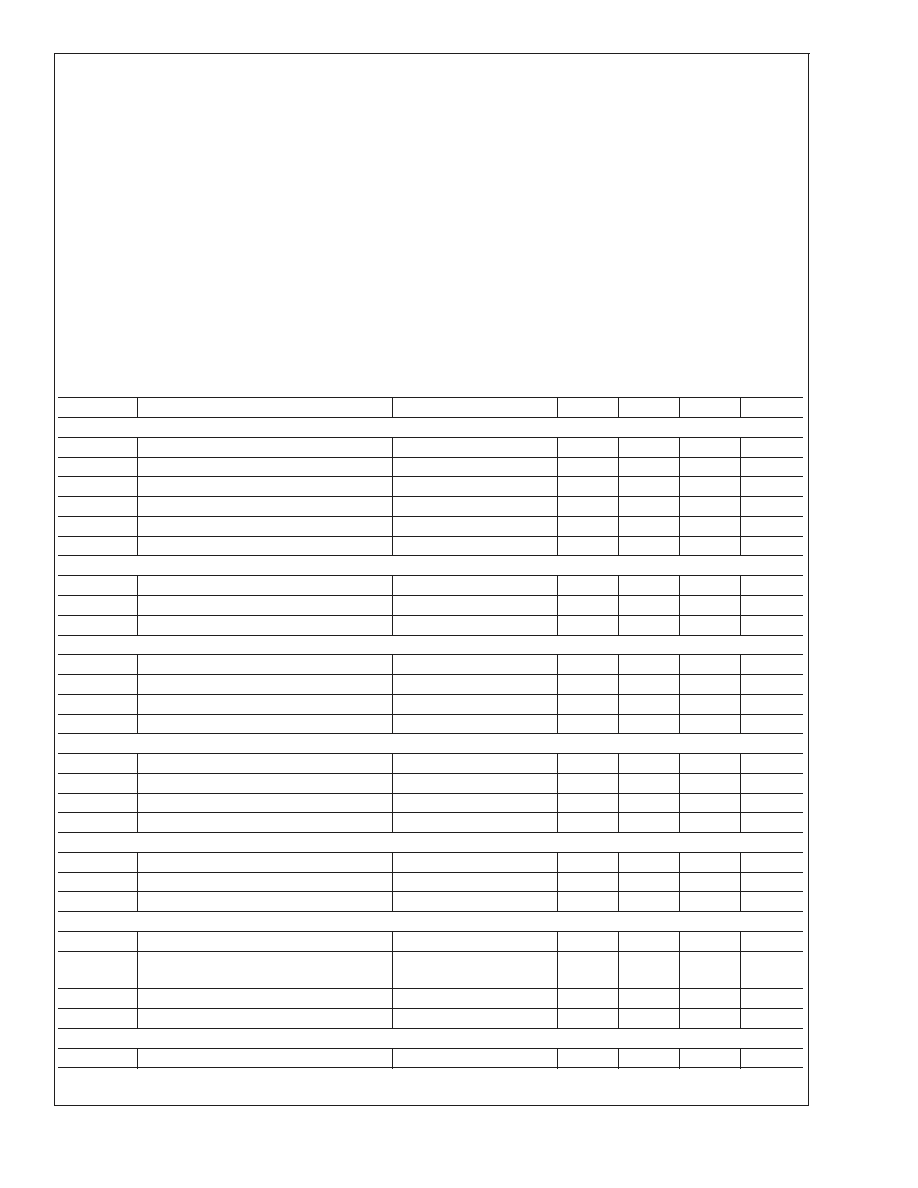
Absolute Maximum Ratings
(Note 1)
If Military/Aerospace specified devices are required,
please contact the National Semiconductor Sales Office/
Distributors for availability and specifications.
V
DD
to V
SS
≠0.3V to +18V
V
HB
to V
HS
≠0.3V to +18V
IN to V
SS
≠0.3V to V
DD
+ 0.3V
LO Output
≠0.3V to V
DD
+ 0.3V
HO Output
V
HS
≠ 0.3V to V
HB
+ 0.3V
V
HS
to V
SS
-1V to +100V
V
HB
to V
SS
118V
RT to V
SS
≠0.3V to 5V
Junction Temperature
+150∞C
Storage Temperature Range
≠55∞C to +150∞C
ESD Rating HBM
(Note 2)
2 kV
Recommended Operating
Conditions
V
DD
+9V to +14V
HS
≠1V to 100V
HB
V
HS
+ 8V to V
HS
+ 14V
HS Slew Rate
<
50V/ns
Junction Temperature
≠40∞C to +125∞C
Electrical Characteristics
Specifications in standard typeface are for T
J
= +25∞C, and those in boldface
type apply over the full operating junction temperature range. Unless otherwise specified, V
DD
= V
HB
= 12V, V
SS
= V
HS
=
0V, RT = 100k
. No Load on LO or HO.
Symbol
Parameter
Conditions
Min
Typ
Max
Units
SUPPLY CURRENTS
I
DD
V
DD
Quiescent Current
LI = HI = 0V
0.4
0.6
mA
I
DDO
V
DD
Operating Current
f = 500 kHz
1.9
3
mA
I
HB
Total HB Quiescent Current
LI = HI = 0V
0.06
0.2
mA
I
HBO
Total HB Operating Current
f = 500 kHz
1.3
3
mA
I
HBS
HB to V
SS
Current, Quiescent
V
HS
= V
HB
= 100V
0.05
10
µA
I
HBSO
HB to V
SS
Current, Operating
f = 500 kHz
0.08
mA
INPUT PINS
V
IL
Low Level Input Voltage Threshold
0.8
1.8
V
V
IH
High Level Input Voltage Threshold
1.8
2.2
V
R
I
Input Pulldown Resistance
100
200
500
k
TIME DELAY CONTROLS
V
RT
Nominal Voltage at RT
2.7
3
3.3
V
I
RT
RT Pin Current Limit
RT = 0V
0.75
1.5
2.25
mA
T
D1
Delay Timer, RT = 10 k
58
90
130
ns
T
D2
Delay Timer, RT = 100 k
140
200
270
ns
UNDER VOLTAGE PROTECTION
V
DDR
V
DD
Rising Threshold
6.0
6.9
7.4
V
V
DDH
V
DD
Threshold Hysteresis
0.5
V
V
HBR
HB Rising Threshold
5.7
6.6
7.1
V
V
HBH
HB Threshold Hysteresis
0.4
V
BOOT STRAP DIODE
V
DL
Low-Current Forward Voltage
I
VDD-HB
= 100 µA
0.60
0.9
V
V
DH
High-Current Forward Voltage
I
VDD-HB
= 100 mA
0.85
1.1
V
R
D
Dynamic Resistance
I
VDD-HB
= 100 mA
0.8
1.5
LO GATE DRIVER
V
OLL
Low-Level Output Voltage
I
LO
= 100 mA
0.25
0.4
V
V
OHL
High-Level Output Voltage
I
LO
= ≠100 mA
V
OHL
= V
DD
≠ V
LO
0.35
0.55
V
I
OHL
Peak Pullup Current
V
LO
= 0V
1.6
A
I
OLL
Peak Pulldown Current
V
LO
= 12V
1.8
A
HO GATE DRIVER
V
OLH
Low-Level Output Voltage
I
HO
= 100 mA
0.25
0.4
V
LM5104
www.national.com
3

Electrical Characteristics
Specifications in standard typeface are for T
J
= +25∞C, and those in boldface type
apply over the full operating junction temperature range. Unless otherwise specified, V
DD
= V
HB
= 12V, V
SS
= V
HS
= 0V,
RT = 100k
. No Load on LO or HO. (Continued)
Symbol
Parameter
Conditions
Min
Typ
Max
Units
V
OHH
High-Level Output Voltage
I
HO
= ≠100 mA,
V
OHH
= V
HB
≠ V
HO
0.35
0.55
V
I
OHH
Peak Pullup Current
V
HO
= 0V
1.6
A
I
OLH
Peak Pulldown Current
V
HO
= 12V
1.8
A
THERMAL RESISTANCE
JA
Junction to Ambient
SOIC-8
170
∞C/W
LLP-10 (Note 3)
40
Switching Characteristics
Specifications in standard typeface are for T
J
= +25∞C, and those in boldface
type apply over the full operating junction temperature range. Unless otherwise specified, V
DD
= V
HB
= 12V, V
SS
= V
HS
=
0V, No Load on LO or HO .
Symbol
Parameter
Conditions
Min
Typ
Max
Units
t
LPHL
Lower Turn-Off Propagation Delay (IN
Rising to LO Falling)
25
56
ns
t
HPHL
Upper Turn-Off Propagation Delay (IN
Falling to HO Falling)
25
56
ns
t
RC
, t
FC
Either Output Rise/Fall Time
C
L
= 1000 pF
15
ns
t
R
, t
F
Either Output Rise/Fall Time
(3V to 9V)
C
L
= 0.1 µF
0.6
µs
t
BS
Bootstrap Diode Turn-Off Time
I
F
= 20 mA, I
R
= 200 mA
50
ns
Note 1: Absolute Maximum Ratings indicate limits beyond which damage to the component may occur. Operating Ratings are conditions under which operation of
the device is guaranteed. Operating Ratings do not imply guaranteed performance limits. For guaranteed performance limits and associated test conditions, see the
Electrical Characteristics tables.
Note 2: The human body model is a 100 pF capacitor discharged through a 1.5k
resistor into each pin. 2 kV for all pins except Pin 2, Pin 3 and Pin 4 which are
rated at 500V.
Note 3: 4 layer board with Cu finished thickness 1.5/1/1/1.5 oz. Maximum die size used. 5x body length of Cu trace on PCB top. 50 x 50mm ground and power
planes embedded in PCB. See Application Note AN-1187.
Note 4: Min and Max limits are 100% production tested at 25∞C. Limits over the operating temperature range are guaranteed through correlation using Statistical
Quality Control (SQC) methods. Limits are used to calculate National's Average Outgoing Quality Level (AOQL).
Note 5: The
JA
is not a given constant for the package and depends on the printed circuit board design and the operating environment.
LM5104
www.national.com
4
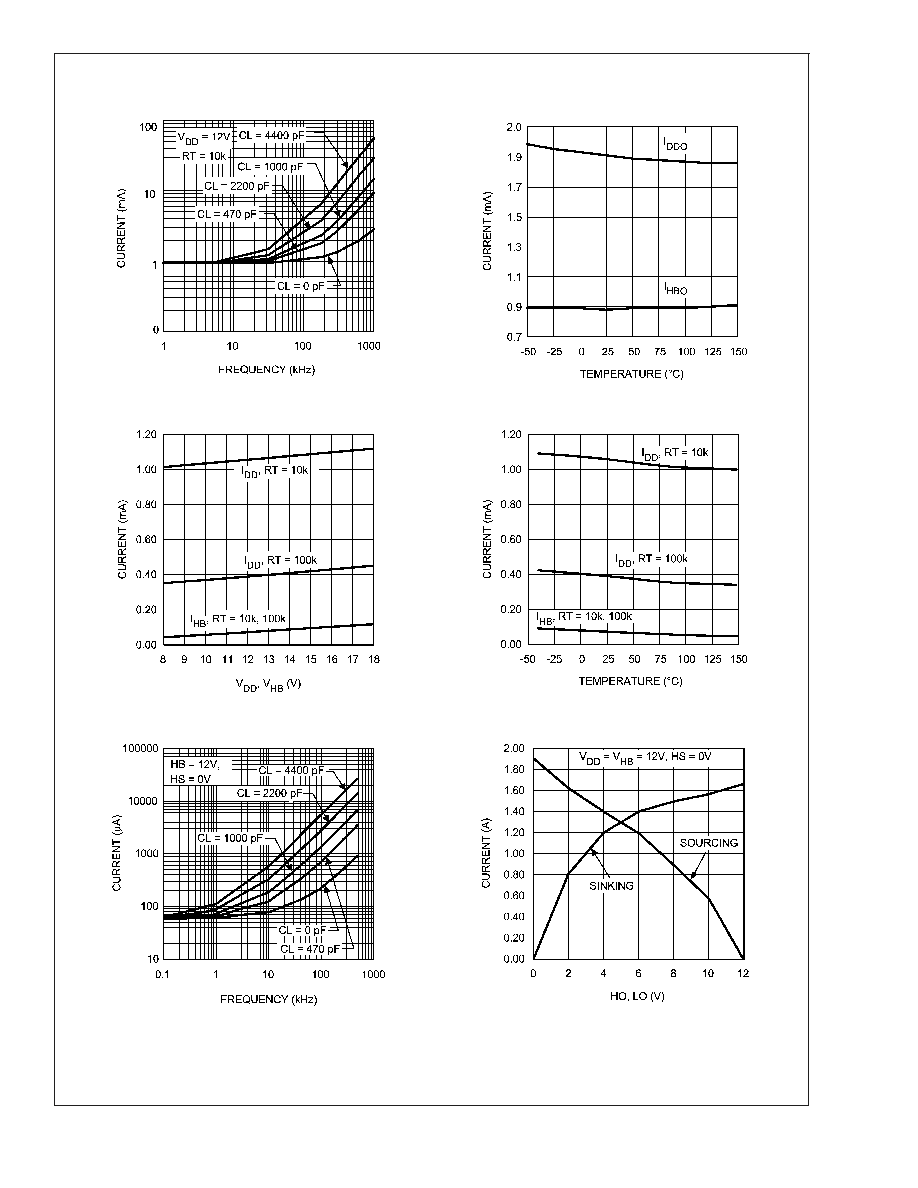
Typical Performance Characteristics
I
DD
vs Frequency
Operating Current vs Temperature
20089010
20089011
Quiescent Current vs Supply Voltage
Quiescent Current vs Temperature
20089012
20089013
I
HB
vs Frequency
HO & LO Peak Output Current vs Output Voltage
20089017
20089018
LM5104
www.national.com
5
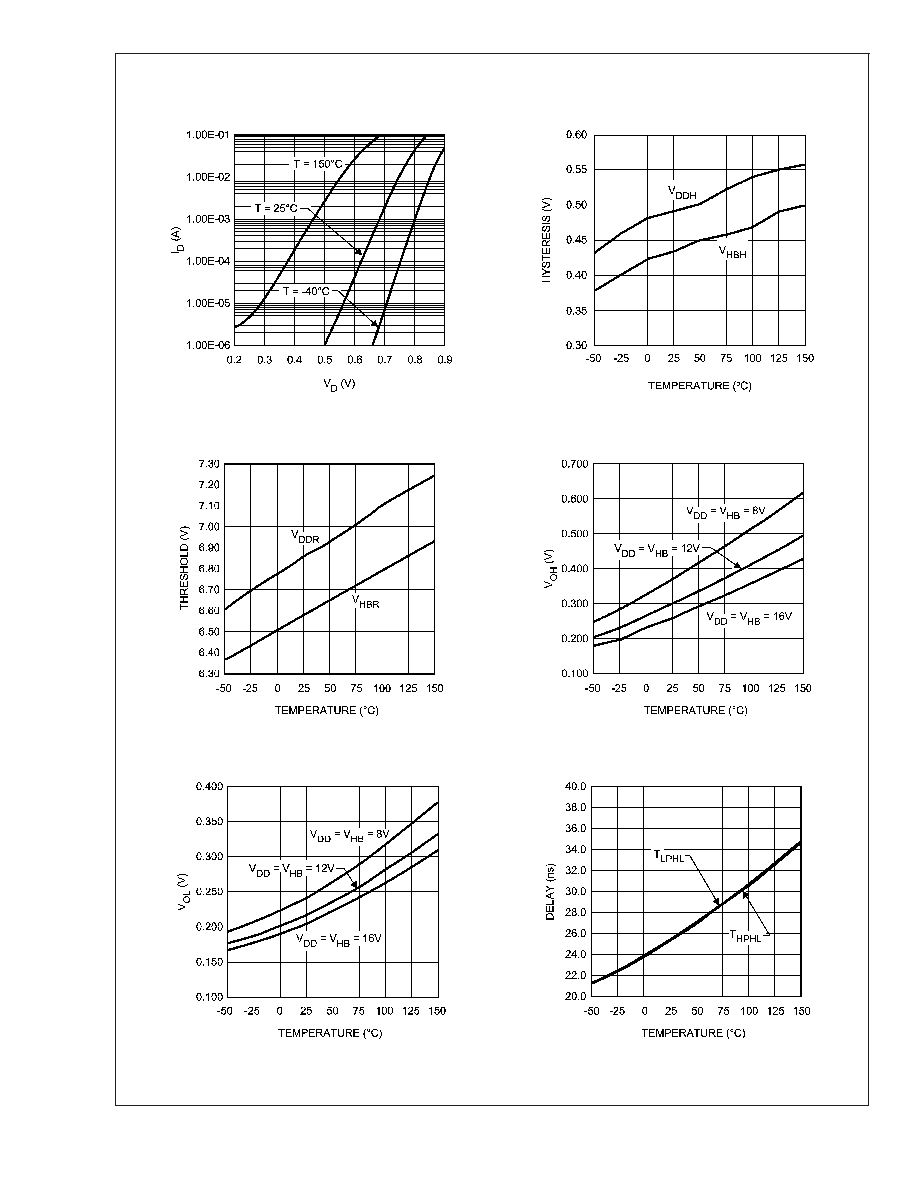
Typical Performance Characteristics
(Continued)
Diode Forward Voltage
Undervoltage Threshold Hysteresis vs Temperature
20089016
20089019
Undervoltage Rising Threshold vs Temperature
LO & HO Gate Drive -- High Level Output Voltage vs
Temperature
20089020
20089021
LO & HO Gate Drive -- Low Level Output Voltage vs
Temperature
Turn Off Propagation Delay vs Temperature
20089022
20089023
LM5104
www.national.com
6
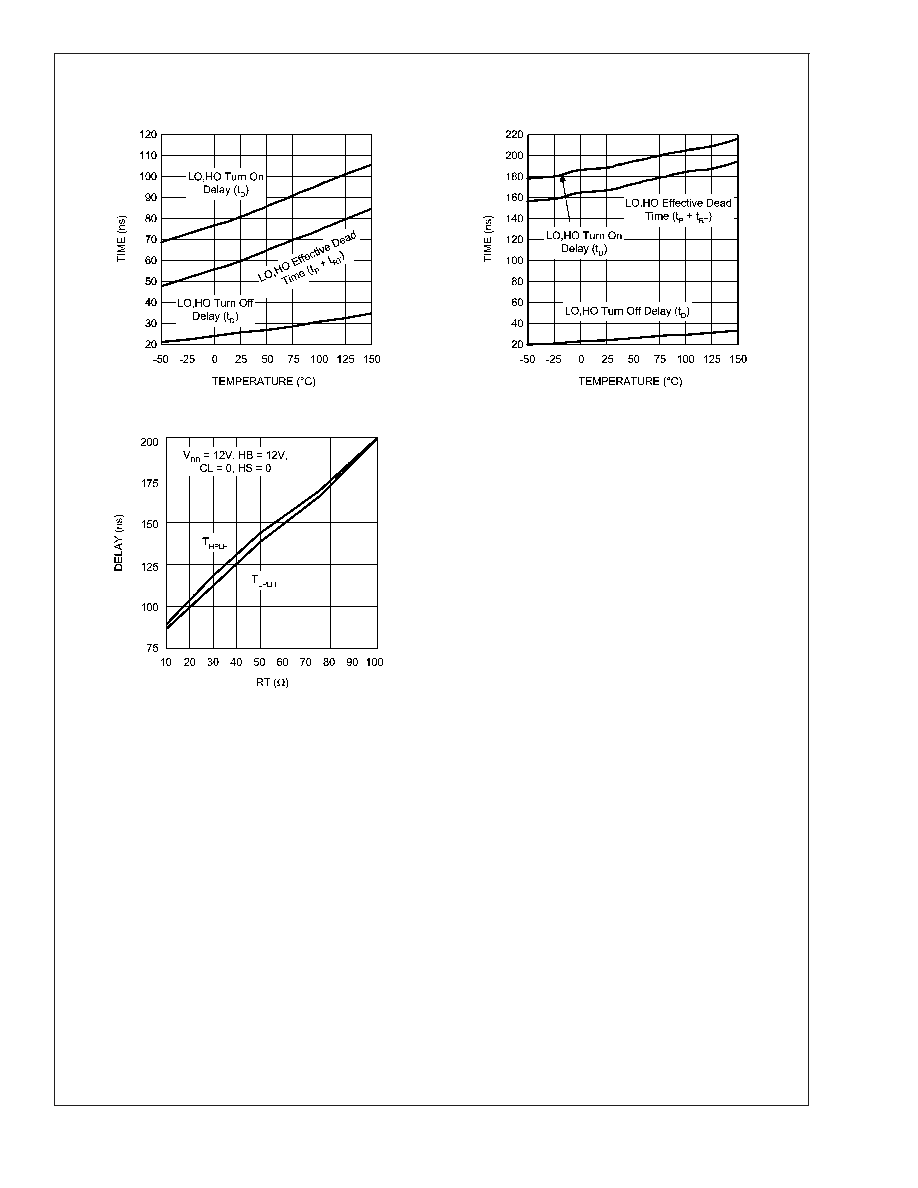
Typical Performance Characteristics
(Continued)
Timing vs Temperature RT = 10K
Timing vs Temperature RT = 100K
20089015
20089024
Turn On Delay vs RT Resistor Value
20089014
LM5104
www.national.com
7
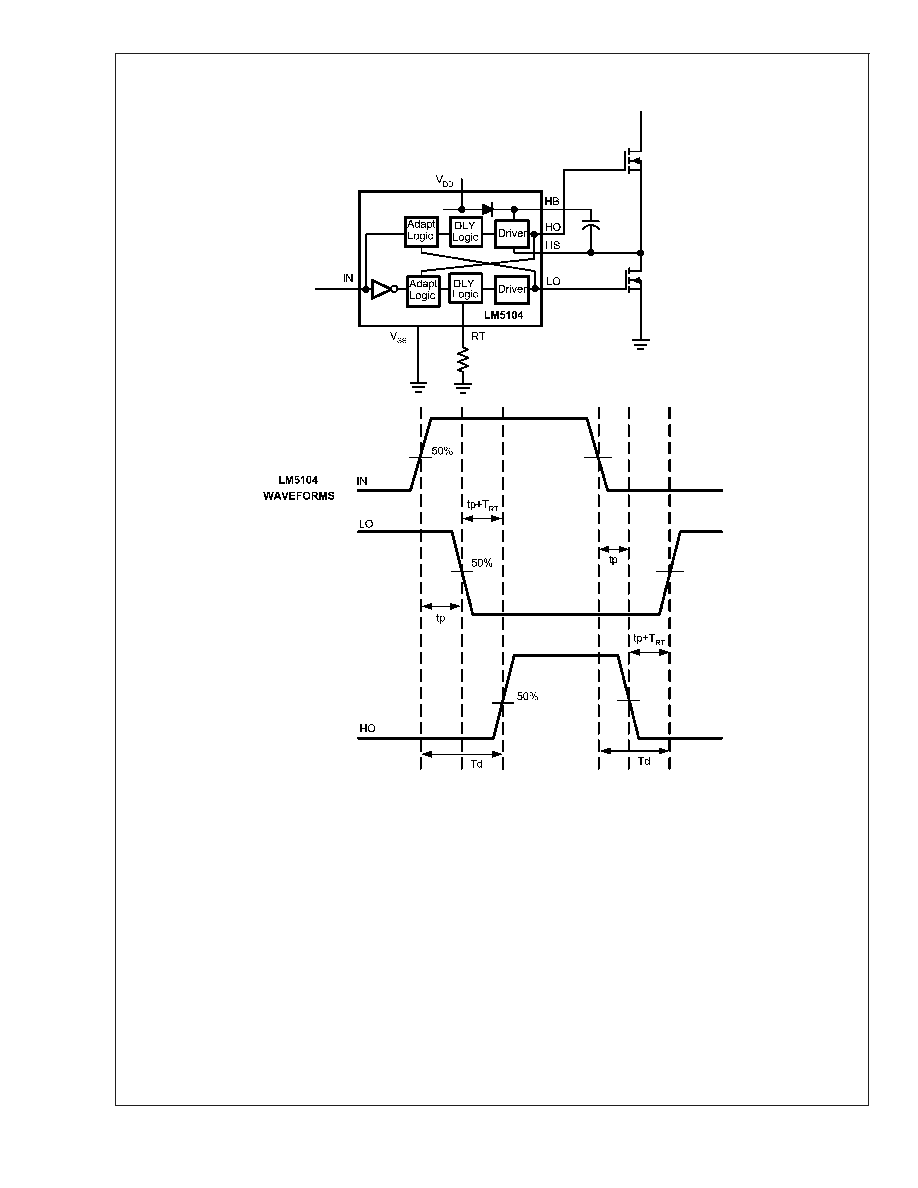
LM5104 Waveforms
Operational Description
ADAPTIVE SHOOT-THROUGH PROTECTION
LM5104 is a high voltage, high speed dual output driver
designed to drive top and bottom MOSFET's connected in
synchronous buck or half-bridge configuration, from one ex-
ternally provided PWM signal. LM5104 features adaptive
delay to prevent shoot-through current through top and bot-
tom MOSFETs during switching transitions. Referring to the
timing diagram Figure 3, the rising edge of the PWM input
(IN) turns off the bottom MOSFET (LO) after a short propa-
gation delay (t
P
). An adaptive circuit in the LM5104 monitors
the bottom gate voltage (LO) and triggers a programmable
delay generator when the LO pin falls below an internally set
threshold (
Vdd/2). The gate drive of the upper MOSFET
(HO) is disabled until the deadtime expires. The upper gate
is enabled after the TIMER delay (t
P
+T
RT
) , and the upper
MOSFET turns-on. The additional delay of the timer pre-
vents lower and upper MOSFETs from conducting simulta-
neously, thereby preventing shoot-through.
A falling transition on the PWM signal (IN) initiates the turn-
off of the upper MOSFET and turn-on of the lower MOSFET.
A short propagation delay (t
P
) is encountered before the
upper gate voltage begins to fall. Again, the adaptive shoot-
through circuitry and the programmable deadtime TIMER
delays the lower gate turn-on time. The upper MOSFET gate
voltage is monitored and the deadtime delay generator is
triggered when the upper MOSFET gate voltage with respect
to ground drops below an internally set threshold (
Vdd/2).
The lower gate drive is momentarily disabled by the timer
and turns on the lower MOSFET after the deadtime delay
expires (t
P
+T
RT
).
20089005
FIGURE 3. Application Timing Waveforms
LM5104
www.national.com
8
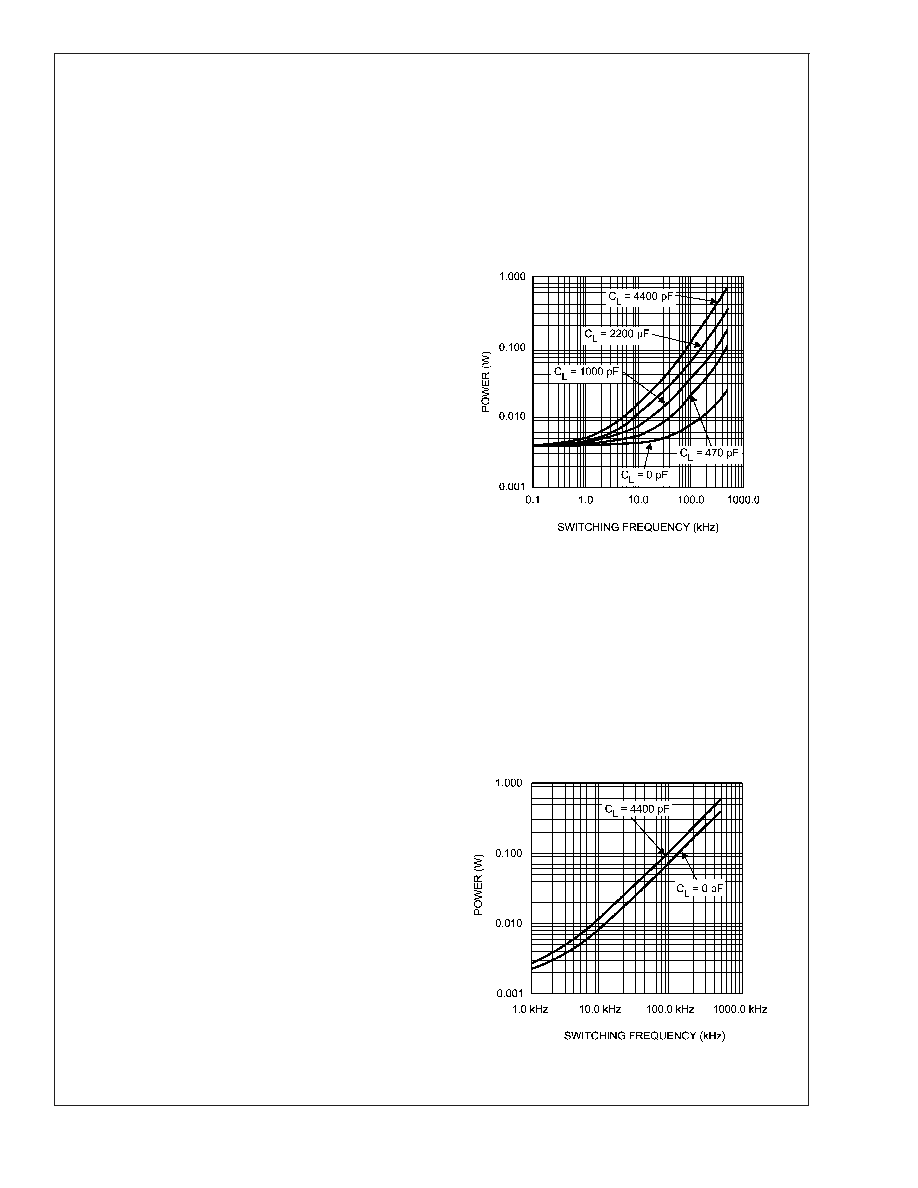
Operational Description
(Continued)
The RT pin is biased at 3V and current limited to 1mA. It is
designed to accommodate a resistor between 5K and 100K,
resulting in an effective dead-time proportional to RT and
ranging from 90ns to 200ns. RT values below 5K will satu-
rate the timer and are not recommended.
Startup and UVLO
Both top and bottom drivers include under-voltage lockout
(UVLO) protection circuitry which monitors the supply volt-
age (V
DD
) and bootstrap capacitor voltage (V
HB
≠ V
HS
)
independently. The UVLO circuit inhibits each driver until
sufficient supply voltage is available to turn-on the external
MOSFETs, and the built-in hysteresis prevents chattering
during supply voltage transitions. When the supply voltage is
applied to V
DD
pin of LM5104, the top and bottom gates are
held low until V
DD
exceeds UVLO threshold, typically about
6.9V. Any UVLO condition on the bootstrap capacitor will
disable only the high side output (HO).
LAYOUT CONSIDERATIONS
The optimum performance of high and low side gate drivers
cannot be achieved without taking due considerations during
circuit board layout. Following points are emphasized.
1.
A low ESR/ESL capacitor must be connected close to
the IC, and between V
DD
and V
SS
pins and between HB
and HS pins to support high peak currents being drawn
from V
DD
during turn-on of the external MOSFET.
2.
To prevent large voltage transients at the drain of the top
MOSFET, a low ESR electrolytic capacitor must be con-
nected between MOSFET drain and ground (V
SS
).
3.
In order to avoid large negative transients on the switch
node (HS) pin, the parasitic inductances in the source of
top MOSFET and in the drain of the bottom MOSFET
(synchronous rectifier) must be minimized.
4.
Grounding considerations:
a) The first priority in designing grounding connections is
to confine the high peak currents from charging and
discharging the MOSFET gate in a minimal physical
area. This will decrease the loop inductance and mini-
mize noise issues on the gate terminal of the MOSFET.
The MOSFETs should be placed as close as possible to
the gate driver.
b) The second high current path includes the bootstrap
capacitor, the bootstrap diode, the local ground refer-
enced bypass capacitor and low side MOSFET body
diode. The bootstrap capacitor is recharged on the
cycle-by-cycle basis through the bootstrap diode from
the ground referenced V
DD
bypass capacitor. The re-
charging occurs in a short time interval and involves high
peak current. Minimizing this loop length and area on the
circuit board is important to ensure reliable operation.
5.
The resistor on the RT pin must be placed very close to
the IC and seperated from high current paths to avoid
noise coupling to the time delay generator which could
disrupt timer operation.
POWER DISSIPATION CONSIDERATIONS
The total IC power dissipation is the sum of the gate driver
losses and the bootstrap diode losses. The gate driver
losses are related to the switching frequency (f), output load
capacitance on LO and HO (C
L
), and supply voltage (V
DD
)
and can be roughly calculated as:
P
DGATES
= 2
∑
f
∑
C
L
∑
V
DD
2
There are some additional losses in the gate drivers due to
the internal CMOS stages used to buffer the LO and HO
outputs. The following plot shows the measured gate driver
power dissipation versus frequency and load capacitance. At
higher frequencies and load capacitance values, the power
dissipation is dominated by the power losses driving the
output loads and agrees well with the above equation. This
plot can be used to approximate the power losses due to the
gate drivers.
Gate Driver Power Dissipation (LO + HO)
V
CC
= 12V, Neglecting Diode Losses
20089006
The bootstrap diode power loss is the sum of the forward
bias power loss that occurs while charging the bootstrap
capacitor and the reverse bias power loss that occurs during
reverse recovery. Since each of these events happens once
per cycle, the diode power loss is proportional to frequency.
Larger capacitive loads require more current to recharge the
bootstrap capacitor resulting in more losses. Higher input
voltages (V
IN
) to the half bridge result in higher reverse
recovery losses. The following plot was generated based on
calculations and lab measurements of the diode recovery
time and current under several operating conditions. This
can be useful for approximating the diode power dissipation.
Diode Power Dissipation V
IN
= 80V
20089007
LM5104
www.national.com
9
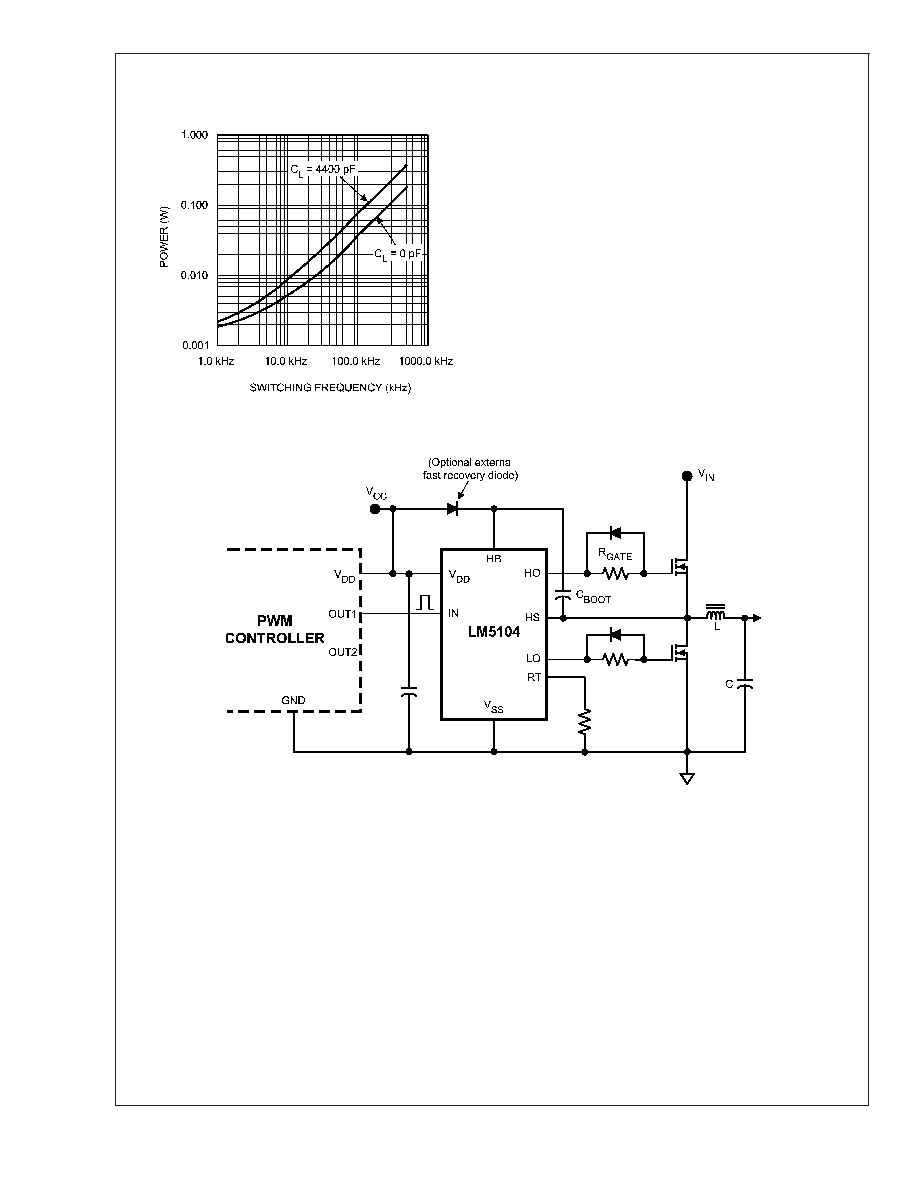
Startup and UVLO
(Continued)
Diode Power Dissipation V
IN
= 40V
20089008
The total IC power dissipation can be estimated from the
above plots by summing the gate drive losses with the
bootstrap diode losses for the intended application. Because
the diode losses can be significant, an external diode placed
in parallel with the internal bootstrap diode (refer to Figure 4)
can be helpful in removing power from the IC. For this to be
effective, the external diode must be placed close to the IC to
minimize series inductance and have a significantly lower
forward voltage drop than the internal diode.
20089009
FIGURE 4. LM5104 Driving MOSFETs Connected in Synchronous Buck Configuration
LM5104
www.national.com
10
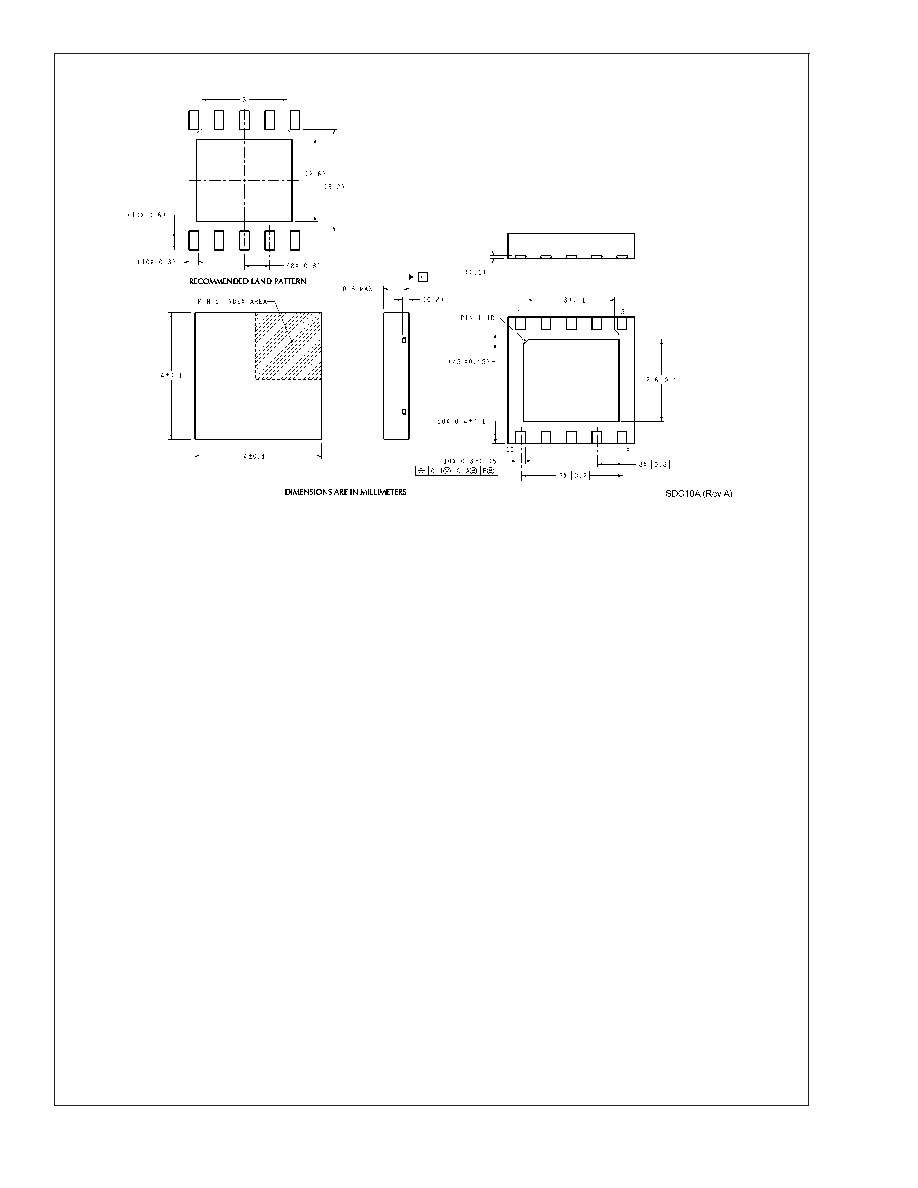
Physical Dimensions
inches (millimeters) unless otherwise noted
Notes: Unless otherwise specified
1.
Standard lead finish to be 200 microinches/5.00 micrometers minimum tin/lead (solder) on copper.
2.
Pin 1 identification to have half of full circle option.
3.
No JEDEC registration as of Feb. 2000.
LLP-10 Outline Drawing
NS Package Number SDC10A
LM5104
www.national.com
11
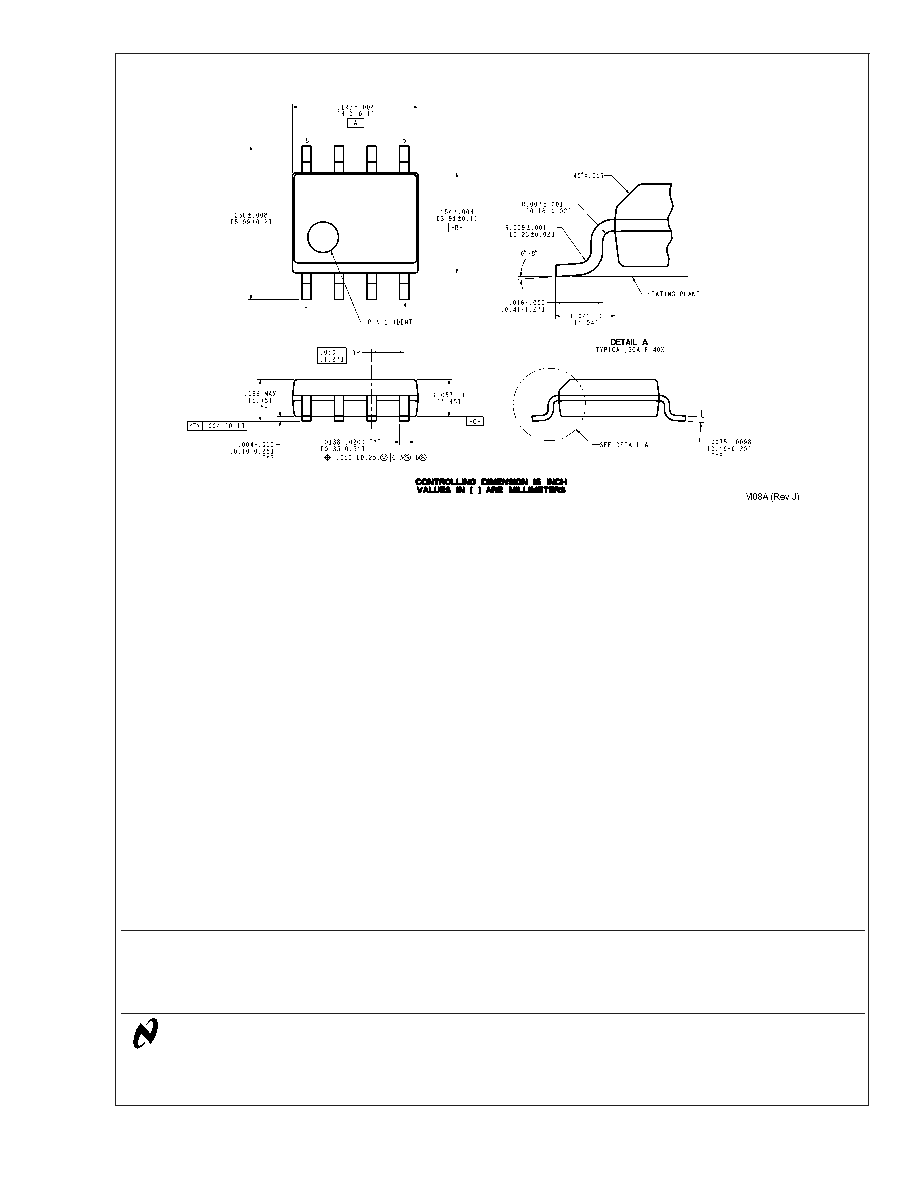
Physical Dimensions
inches (millimeters) unless otherwise noted (Continued)
Notes: Unless otherwise specified
1.
For solder thickness and composition, see "Solder Information" in the packaging section of the National Semiconductor web
page (www.national.com).
2.
Maximum allowable metal burr on lead tips at the package edges is 76 microns.
3.
No JEDEC registration as of May 2003.
SOIC-8 Outline Drawing
NS Package Number M08A
LIFE SUPPORT POLICY
NATIONAL'S PRODUCTS ARE NOT AUTHORIZED FOR USE AS CRITICAL COMPONENTS IN LIFE SUPPORT
DEVICES OR SYSTEMS WITHOUT THE EXPRESS WRITTEN APPROVAL OF THE PRESIDENT AND GENERAL
COUNSEL OF NATIONAL SEMICONDUCTOR CORPORATION. As used herein:
1. Life support devices or systems are devices or
systems which, (a) are intended for surgical implant
into the body, or (b) support or sustain life, and
whose failure to perform when properly used in
accordance with instructions for use provided in the
labeling, can be reasonably expected to result in a
significant injury to the user.
2. A critical component is any component of a life
support device or system whose failure to perform
can be reasonably expected to cause the failure of
the life support device or system, or to affect its
safety or effectiveness.
BANNED SUBSTANCE COMPLIANCE
National Semiconductor certifies that the products and packing materials meet the provisions of the Customer Products
Stewardship Specification (CSP-9-111C2) and the Banned Substances and Materials of Interest Specification
(CSP-9-111S2) and contain no ``Banned Substances'' as defined in CSP-9-111S2.
National Semiconductor
Americas Customer
Support Center
Email: new.feedback@nsc.com
Tel: 1-800-272-9959
National Semiconductor
Europe Customer Support Center
Fax: +49 (0) 180-530 85 86
Email: europe.support@nsc.com
Deutsch Tel: +49 (0) 69 9508 6208
English
Tel: +44 (0) 870 24 0 2171
FranÁais Tel: +33 (0) 1 41 91 8790
National Semiconductor
Asia Pacific Customer
Support Center
Email: ap.support@nsc.com
National Semiconductor
Japan Customer Support Center
Fax: 81-3-5639-7507
Email: jpn.feedback@nsc.com
Tel: 81-3-5639-7560
www.national.com
LM5104
High
V
oltage
Half-Bridge
Gate
Driver
with
Adaptive
Delay
National does not assume any responsibility for use of any circuitry described, no circuit patent licenses are implied and National reserves the right at any time without notice to change said circuitry and specifications.











